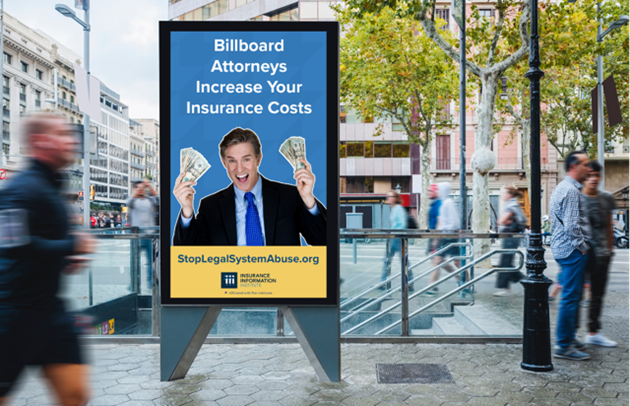
By Dale Porfilio, Chief Insurance Officer, Insurance Information Institute
As part of its ongoing work to raise awareness of the impacts of legal system abuse, the Insurance Information Institute (Triple-I) launched a multi-faceted campaign focusing on Georgia. The campaign includes an Interstate 20 billboard in Downtown Atlanta and digital billboards on bus stops and other urban panels across the Metro Atlanta area.
Georgia tops the most recent list of places that the American Tort Reform Foundation (ATRF) calls “judicial hellholes,” states and counties where the organization believes judges in civil cases systematically apply laws and court procedures generally to the disadvantage of defendants. According to ATRF, Georgia earned this ranking due to continued “high nuclear verdicts and liability-expanding decisions by the Georgia Supreme Court.” The state made the list for the first time in the report for 2019-2020, debuting at number 6.
Triple-I and key insurance industry stakeholders define legal system abuse as policyholder or plaintiff attorney practices that increase costs and time to settle insurance claims, including situations when a disputed claim could have been resolved without judicial intervention. Insurers’ legal costs for claims can mount with the increasing number of lawsuit filings, extended litigation, and outsized jury awards (awards exceeding $10 million). Data from the Insurance Research Council (IRC) indicates that attorney involvement can increase claims costs and the time needed to resolve them, even while reducing value for claimants.
Auto insurance litigation, for example, is a growing concern in Georgia as data reveals coverage affordability for Georgians in this product area has been significantly waning faster than in any other state. An August 2024 report, Personal Auto Insurance Affordability in Georgia, issued by IRC, ranked Georgia 47th in terms of auto insurance affordability. Personal auto insurance expenditures accounted for 2.0 percent of Georgians’ median household income, compared with a 1.5 percent share nationwide. Auto insurance spending in Georgia grew at 5.6 percent annualized between 2014 and 2022, compared with 3.3 percent in the country overall.
Meanwhile, legal service providers spent over $160 million on advertising in Georgia in 2023, according to preliminary data from the American Tort Reform Association (ATRA).

Earlier this year, a Triple-I issue brief, Legal System Abuse: State of the Risk, highlighted aspects of legal system abuse, including how law firm advertising spend for mass tort cases might play a role in increased filings nationwide. Trial attorneys and third-party litigation funders seeking more profits may use advertising to amp up recruitment for lawsuits with big payouts at the expense of policyholders. A 2023 Triple-I study, Impact of Increasing Inflation on Personal and Commercial Auto Liability Insurance, estimates that increasing inflation drove loss and DCC (defense containment costs) higher in both insurance lines – by 6.5 percent ($61 billion) of total loss and DCC for personal auto and by 19 to 24 percent ($35 to $44 billion) for commercial auto.
Triple-I’s multi-faceted awareness campaign to help educate Georgians about the mounting costs of legal system abuse in the state also includes content such as a video statement by CEO Sean Kevelighan and interviews capturing the opinions of consumers about legal system abuse.
Coverage affordability is a growing concern for many policyholders nationwide. While several factors may impact insurance premiums, unnecessary and excessive litigation can drive higher loss ratios while posing formidable challenges to prediction and mitigation. Triple-I is committed to advancing conversations with business leaders, government regulators, consumers, and other stakeholders to attack the risk crisis and chart a path forward.
We invite you to join the discussion by registering for JIF 2024. Follow our blog to learn more about trends in insurance affordability and availability across the property and casualty market.

